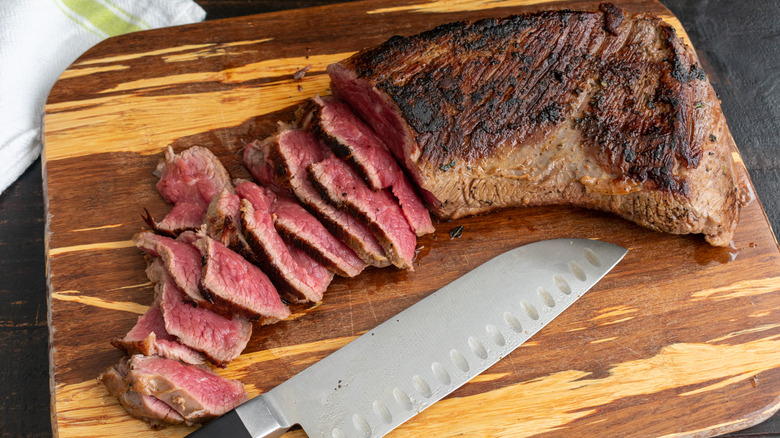One taste of tri-tip — the treasured cut that gained fame in the mid-20th century thanks to a Santa Maria, California, butcher who repurposed meat meant for hamburgers (according to local lore) — and it’s easy to see why this flavorful yet affordable steak caught on outside of SoCal. Thanks to its intricate marbling (the fat nestled in between the muscle), the cut is incredibly beefy and rich. But to truly bring out its tender texture, there are a couple of rules to follow. Matt Abdoo, executive chef and co-founder of Pig Beach BBQ, which has locations in New York, Boston, and Florida, told Chowhound that tri-tip success starts with how you cook it.
“To get the juiciest texture from a tri-tip steak,” he says, “the most important thing is not to overcook it — tri-tip is best enjoyed around medium doneness. Anything past that and it starts to dry out.” Once the steak has reached that perfectly pink medium temperature, Abdoo recommends taking it off the heat and letting it rest for around five minutes before slicing so the juices redistribute. “Cutting too soon can cause them to run out,” he warns.
To ace carving this cut, Abdoo is adamant about going against the grain. Examine the tri-tip to identify the direction that the muscle fibers run in, then make your cut perpendicular to the lines. The muscle itself is tough and hard to chew through, so shortening those fibers with your knife delivers maximum tenderness. While this would be straightforward enough advice for most steak, tri-tip is a trickier beast.
Going against the grain yields a cut above the rest
If you went ahead and completed that visual inspection of the tri-tip steak, though, you might have encountered a problem with the grain. The tri-tip is so named because of its triangular shape, and as such, its grain is divided into both a vertical and a horizontal pattern. “The grain in a tri-tip changes direction,” explains Matt Abdoo, referring to how the fibers fan out from one corner of the triangular cut. “So, it’s important to adjust your slicing as you go to ensure you’re always cutting against the grain,” he says.
If you suddenly see straight lines as you’re cutting the meat, it means you’ve veered into with-the-grain slicing. Long muscle fibers are strong — cutting along the fibers leaves their toughness intact, while cutting across them helps weaken their hold. Cutting with the grain instead of against it will cause the tri-tip to be too firm and chewy, rather than deliciously tender.
Luckily, you can always correct your cut. If you find yourself looking at straight lines, “simply rotate the steak or your knife about 90 degrees and try again,” Abdoo says. You want to see that white (or possibly yellow) marbling and succulent texture in the meat — that’s an indication that you’re cutting in the right direction. The proper slicing technique will ensure the best texture, Abdoo notes, “and you’ll get a more tender, flavorful bite.”






